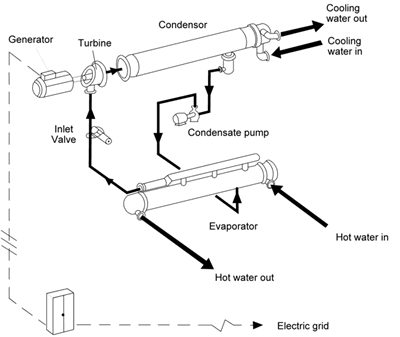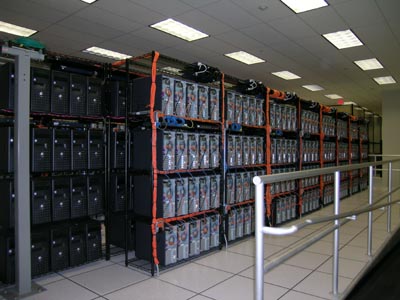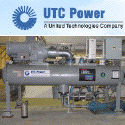Blog Archives
Organic Rankine Cycle
The Organic Rankine Cycle (ORC) is a fancy name for a binary system taking heat from a source and transferring it to a working liquid in a closed system to be vaporized and pressurized, typically turn a turbine, then condense back to liquid form before flowing through the heat exchanger again to repeat the cycle. The diagram below breaks out the typical components of an ORC system.

These systems can vary in size from a few hundred kilowatts clear up to hundreds of megawatts. A picture of a 200Kw system is displayed below.

These ORC systems have several key benefits over traditional steam turbines including lower operating temperature (down to 75C,) less wear and tear on turbines (clean single fluid environment,) and no requirement to expose heat source to the environment (no emission power generation is possible using these units in a closed geothermal system for instance.) The major disadvantage to this approach is that energy is lost during the heat transfer process relative to direct use systems.
Technorati Tags: Energy | Science | Geothermal
$428 per server per year
Garden variety data center photo

Yesterday I had a conversation with a colleague who is now working in a large, and I mean large, server environment. There are many challenges he faces, but chief among them is power consumption and cost. They are now having to place their data centers according to power supply capabilities and cost rather than other business factors like proximity to trained work force and real estate cost.
My colleague mentioned that they’re spending, fully loaded with lighting, cooling, etc., some $428 per server instance per year in power costs. I agreed to not disclose the name of the company (you’d recognize it) or his name (you wouldn’t recognize it) – but the scale of this is huge. Tens of thousands of servers and tens of millions of dollars spent on power annually.
One other thing worth noting is an unwanted and unused by product of all that activity – millions and millions of excess BTUs at about 25C in temperature.
There is certainly room for improvement in this situation, even with the work that AMD and Sun have done on the power consumption side for servers.
Technorati Tags: Energy | Heat | Data Center
Return to the age of sail?

You know fuel prices are going up and carbon emissions standards are tightening when we return to a prior age to harvest technology. Now admittedly, the picture above isn’t your garden variety xebec (great scrabble word btw,) but it is interesting that the hybrid technology of the 19th century is making a comeback.
This kind of reminds me of kite surfing technology wed to a cargo ship. Pretty different than the prior implementations that combined coal burning steam engines with traditional sailing ship technology. I’m looking forward to seeing one of these things pass by my window.
Technorati Tags: Sailing | Ship | Hybrid
Seismic activity at The Geysers
One of the tidbits picked up on our recent trip to The Geysers was about the seismic activity around the resource. Since it is a geothermal resource, one of the things an exploration team looks for is seismic activity as it is a primary indicator of resource.
It was a surprise to me (but really shouldn’t have been) that the seismic activity in the region has increased both in frequency of activity and magnitude since the field has been in production. Logically, one would expect that if you’re taking huge amounts of mass from underground that there would be some impact, at the very least, subsidence. This isn’t to say there are huge cataclysmic quakes happening, the quakes tend to be small and frequent.
Click the map to visit the USGS for more detail.

As you can see from the USGS quake map above, there are 52 quakes in the past week, the cluster of events near the left, top of the map is in The Geysers region. The magnitude of these quakes range from 1-3 typically, though a 4.4 was registered in the Calpine leasehold in the past few years. Curiously, the activity has increased with the injection measures taken to replace mass extracted from the production wells. Since the reservoir is a series of fractures in a confined space, this may be from overloading certain areas of the reservoir rather than a more even distribution of the injected fluid across the fissures.
Nevertheless, a very interesting side effect of the geothermal activity in The Geysers region.
Technorati Tags: Energy | Geothermal | Earthquake
Field Trip to the Geysers
Yesterday, two colleagues and I had the chance to visit a geothermal plant at The Geysers in Lake County, California. For those of you not familiar with the area, it’s near Middletown on Highway 29 about 32km (20m) north of Calistoga. There is a very narrow valley between two ~1,000m (~3,000′) elevation ridgelines. On the west ridgeline about 8km (5m) north-northwest of Middletown is an old mining road that winds up onto the ridge. Along the way, one sees well after well all connected by large insulated pipelines headed to one of the 21 active power plants scattered across the landscape.
The major operators on the field now are Calpine (19 plants,) Northern California Power Association (2 plants,) and US Renewables is reworking the Bottle Rock plant due to come online in 2007. Another decomissioned 65MW plant is rumored to be part of a repower project at lower output (~25MW.)
The geothermal resource at The Geysers is relatively rare, it’s dry steam that is produced from the wells (vs. a standard hot fluid that either “flashes” to steam or is used for heat transfer to a working unit in a binary system.) The area being utilized is approximately 11km (7m) long and 8km (5m) wide in the rough shape of a football located some 2,000m (6500′) below the surface. The reservoir rock is a graywacke, a type of sand stone with fractures that capture water and transfer heat from a suspected magma dome below. There are other layers of rock acting as a capstone (trapping the steam in the reservoir) such that it can only escape to the surface through faults and wells.
The resource has been known for some time and has been exploited in some way for more than 40 years, specifically with a large buildout of power plants in the 1980’s. The peak output for the field was 2,100MW during the late 1980’s the output of steam declined some 17-20% per year thereafter to a current production level of around 750MW. Over production aided in the precipitous decline which was largely stemmed by taking the measure of injecting treated wastewater from nearby communities back into the reservoir. The facility we visited yesterday produces some 132MW (120MW net minus the parasitic load of the plant) from 70 production wells and 5 injection wells. While the decline of steam yield continues, it has slowed considerably and is predicted to reach an equilibrium in the next few years with the injection program replacing the mass extracted on a daily basis.
I believe (aside from overproduction) that the major culprit in decline of steam production is due to the condensation of post-turbine steam which is cooled through cooling towers where 70% of the water is lost to evaporation. A closed system would preserve much more of the mass and enable a more effective injection regime (not to mention the opportunity to boost production by using the cooling steam to power binary systems down to 90C.) One other side effect of the steam emission is the requirement to cleanse the steam of sulphur, mercury, and vanadium before it is released into the atmosphere which adds more cost and negative impact from this power generation method.
The physical aspects of the plant we visited were impressive. There were two enormous steam turbines (the “spare” blade waiting nearby weighed 25,000kg – or 27 tons and when functioning spins at 3,600 rpm.) Each turbine was connected to a generator sending electricity to a substation and then onto the grid through a 230kva line in the area. Each generator had a separate gigantic stainless steel condenser box, separator for non-condensable gases (about 0.2% of the steam,) and cooling tower infrastructure. There is a separate Stretford process aspect to the plant that separates the sulphur, mercury, and vanadium from the gas for atmospheric emission. One thing that struck us was the overall cleanliness of the entire operation. I’ve been to coal fired power plants before and they are absolutely filthy despite the efforts by the maintenance staff to keep them clean. These plants are relatively small and very clean by comparison.
We’re grateful to have had the opportunity to visit one of the oldest and largest geothermal power production areas on the planet. We had a great host in a friendly plant manager who had worked out at the site since the late 1970’s and was very knowledgeable and helpful in answering our many queries. We learned a ton and it will be helpful as we embark upon our mission to acquire and operate a renewable energy portfolio. I’m certainly hopeful that another opportunity for a visit will arise.
Technorati Tags: Energy | Geothermal | Electricity








